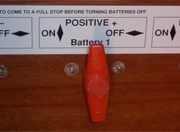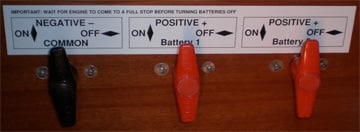DC Electrical System on a Charter Boat
Batteries power the 12 Volt DC “house” electrical system. There may be one or several batteries linked together to supply power. Another separate battery will dedicate power to starting the engine, and some boats have another to supply the windlass although unusual on charter boats. The batteries are usually located close to the engine to minimize cable runs to the alternator, beneath a bunk or settee in the salon.
The battery isolation switch should be located next. It will be located in a seemingly random place somewhere in the boat depending on the boat model. Your boat check-out person will show you where it is. As explained in a previous section regarding engine starting, the house and engine battery systems operate either dependently or independently depending on the boat model. In all cases, however, there are isolation switches that shut off power from all batteries. You’ll certainly need to know this in case of an electrical fire on board.
You’ll need to spend time with your crew showing them through the circuit breaker panel so that they can help you operate the vessel and not bother you with things like turning on the shower pump or the stereo. As discussed in the good leadership section, don’t be an ego monster and hold the secrets of the boat to yourself so that you can look impressive. I had a boss once in the corporate world who played that kind of game. He never was able to gain the respect he thought he deserved. Be a good leader instead and look impressive. Teach people about the boat.
Battery charges must be monitored and maintained to ensure power to the DC systems. The batteries are charged primarily by an alternator, either from the main engine or a generator. Wind, solar, and onboard generators can also contribute to battery charge states but these are rarely on charter boats. Engines and generators usually charge at about 14.1 volts. The battery charger, which runs on AC power from ashore, also recharges the DC system. Batteries charge quite rapidly until about 80% capacity, and then much more slowly after that. They can usually be considered well-charged when the voltmeter – found on most electrical panels – reads about 12.5 volts. The batteries should be recharged when the reading drops to 11.5. It is part of responsible seamanship to monitor the house and engine batteries to prevent deep discharging. Follow the instructions of your charter checkout person regarding the best way to work the house and engine battery system.







